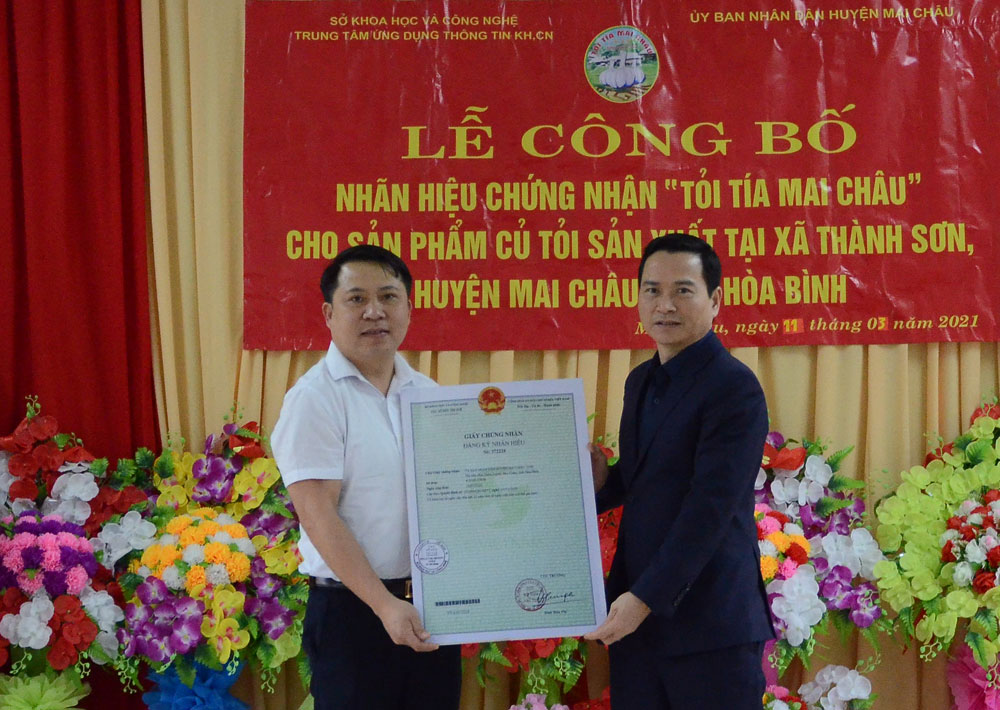
(HBO) - The People’s Committee of Mai Chau district of Hoa Binh province on March 11 held a ceremony to hand over a certificate recognising a garlic variety grown in Thanh Son commune as Mai Chau purple garlic collective brand.
 Leaders of the provincial Department of Science
and Technology hand over the certificate to the Mai Chau People’s Committee.
Leaders of the provincial Department of Science
and Technology hand over the certificate to the Mai Chau People’s Committee.
The variety
has been cultivated in Thanh Son commune for a long time. The plant has small
bulbs, purple sheath and yellow cloves containing a large amount of oil, and a
spicy and delicious flavour.
It is a
Vietnamese specialty suitable for planting in Thanh Son’s climate and soil. The
commune is home to about 12 ha of purple garlic that is often planted in August
and September and ready for harvest more than three months later.
Along its
stem, the part near the bulb is purple, while the bulb turns beige after
harvest. One gram of the garlic contains a high amount of allicin of between
6.81 and 7.23 mg.
The garlic
was recognised as a collective brand by the National Office of Intellectual
Property of Vietnam at the Ministry of Science and Technology under Decision
102266/QD-SHTT dated December 3, 2020.
The
recognition helps affirm the brand of Mai Chau purple garlic and serves as a
foundation to raise its prestige and at the same time promote the product to
targeted markets.
Products earning
the title include those grown and processed in Thanh Son that meet criteria of
quality and related services (buying and selling of garlic).
Mai Chau
district also joined hands with the provincial Department of Science and
Technology in building database, origin tracing system and smart QR stamp for
its products.
At the
handover ceremony, the Mai Chau People’s Committee presented the certificate
stating the right to use the Mai Chau purple garlic collective brand to 30 outstanding
families in Thanh Son. The farmers pledged to capitalise on chances brought
about by the recognition and follow instructions to maintain, protect and
improve product quality as well as intellectual property issues.
Samples of Mai Chau purple garlic recognised by
the National Office of Intellectual Property of Vietnam at the Ministry of
Science and Technology./.
According to data from the Hoa Binh Provincial Party Committee, the industrial production index for the first six months of 2025 is estimated to have increased by 20% compared to the same period last year. This marks the highest year-on-year growth rate for this period since 2020.
In the first six months of 2025, Hoa Binh province’s export turnover was estimated at 1.145 billion USD, marking an 18.11% increase compared to the same period in 2024. Import turnover was estimated at $ 804 million, a 17.15% increase, which helped the province maintain a positive trade balance.
The lives of the ethnic minority farmers in Tan Lac district have gradually improved thanks to the new directions in agricultural production. This is a testament to the collective strength fostered through the professional associations and groups implemented by various levels of the district’s Farmers’ Union.
With the motto the "product quality comes first,” after nearly one year of establishment and operation, Muong village’s Clean Food Agricultural and Commercial Cooperative, located in Cau Hamlet, Hung Son Commune (Kim Boi district), has launched reputable, high-quality agricultural products to the market that are well-received by consumers. The products such as Muong village’s pork sausage, salt-cured chicken, and salt-cured pork hocks have gradually carved out a place in the market and they are on the path to obtaining the OCOP certification.
In the past, the phrase "bumper harvest, rock-bottom prices" was a familiar refrain for Vietnamese farmers engaged in fragmented, small-scale agriculture. But today, a new spirit is emerging across rural areas of Hoa Binh province - one of collaboration, organisation, and collective economic models that provide a stable foundation for production.
Maintaining growing area codes and packing facility codes in accordance with regulations is a mandatory requirement for agricultural products to be eligible for export. Recently, the Department of Agriculture and Environment of Hoa Binh province has intensified technical supervision of designated farming areas and packing facilities to safeguard the "green passport" that enables its products to access international markets.



 Leaders of the provincial Department of Science
and Technology hand over the certificate to the Mai Chau People’s Committee.
Leaders of the provincial Department of Science
and Technology hand over the certificate to the Mai Chau People’s Committee.